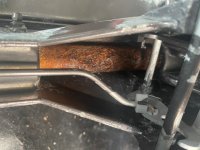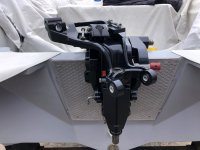hello, new poster. A lot of times, people new to forums encounter "have you tried the search function" when posting questions that have come up before. This old thread https://forums.iboats.com/threads/tohatsu-9-8-corrosion-on-vertical-shaft.641202/ described my situation pretty well so I simply replied to it and then got shut down. Apparently replying to old threads is a no-no here. That must be why they keep them open instead of archiving them, so people can reply to them and get shut down and learn the rule. Got it.
I have a 2003 Tohatsu M9.8 that came on a boat I got last summer and I'd really like to keep going. It runs well and I replaced the water pump right after I got it. Unfortunately I just discovered that the steering shaft is very rusted and corroded. The motor provides aux power for my sailboat, a 27 ft trimaran and the corrosion is bad enough that I'm concerned about continuing to use it before I replace this shaft.
It looks like if ordering the part (3B2Q620100) you don't just get the shaft, you get the yoke (is that right word?) as well, in a single relatively large assembly. Unfortunately Tohatsu USA no longer carries the part. I found a marine store in Japan on e-bay that sells the part new for $200 shipped. Ouch! But I want to keep the engine bad enough that I am considering it.
What is involved in just replacing the shaft? How is the shaft connected to the yoke? If threaded, can I get a 1/2" galvanized pipe, have a machine shop thread the end and drill the holes, and just replace the shaft? Is it going to be a nasty job trying to get the old one out? Doesn't seem like it should be that easy, otherwise why does the part come as a single assembly?
Regardless of whether I find and buy the complete assembly, or just try to fabricate a new shaft, what is best way to get it apart? Sounds like from this thread you can come at it from the top (remove engine head) or the bottom (lower unit), and that coming at it from the bottom would be the easier way. I have some experience with that since I did the water pump a few months ago. So I have some basic mechanical ability but the water pump job took me a few hours so I'm definitely a novice.
Any advice or recommendations appreciated.
I have a 2003 Tohatsu M9.8 that came on a boat I got last summer and I'd really like to keep going. It runs well and I replaced the water pump right after I got it. Unfortunately I just discovered that the steering shaft is very rusted and corroded. The motor provides aux power for my sailboat, a 27 ft trimaran and the corrosion is bad enough that I'm concerned about continuing to use it before I replace this shaft.
It looks like if ordering the part (3B2Q620100) you don't just get the shaft, you get the yoke (is that right word?) as well, in a single relatively large assembly. Unfortunately Tohatsu USA no longer carries the part. I found a marine store in Japan on e-bay that sells the part new for $200 shipped. Ouch! But I want to keep the engine bad enough that I am considering it.
What is involved in just replacing the shaft? How is the shaft connected to the yoke? If threaded, can I get a 1/2" galvanized pipe, have a machine shop thread the end and drill the holes, and just replace the shaft? Is it going to be a nasty job trying to get the old one out? Doesn't seem like it should be that easy, otherwise why does the part come as a single assembly?
Regardless of whether I find and buy the complete assembly, or just try to fabricate a new shaft, what is best way to get it apart? Sounds like from this thread you can come at it from the top (remove engine head) or the bottom (lower unit), and that coming at it from the bottom would be the easier way. I have some experience with that since I did the water pump a few months ago. So I have some basic mechanical ability but the water pump job took me a few hours so I'm definitely a novice.
Any advice or recommendations appreciated.






















